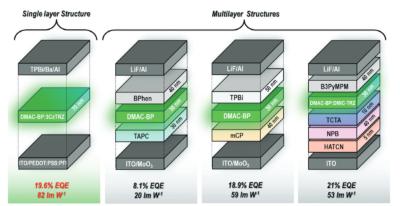In 2023, we reported on research conducted at Germany's Max Planck Institute, led by Prof. Paul W.M. Blom, that looks into single-layer OLED devices. In such devices, a single TADF OLED emitter layer is sandwiched between two electrode - a much simpler design compared to commercial OLED devices that use multilayer stacks, sometimes with 10 or more layers. The researchers the the MPI say that in fact it is possible to develop highly efficient OLEDs with just the TADF emitter - and have demonstrated 100% IQE single-layer devices, with an EQE of 27.7%.
Prof. Blom's group continues to improve its single-layer TADF OLED device, and have now reported that by employing a recently developed trap-free large band gap material as a host for the DMAC-BP OLED emitter, a nearly balanced charge transport is achieved. The device achieves a record power efficiency for DMAC-BP TADF OLEDs of 82 lm/W - surpassing the best reported multilayer power efficiencies of 52.9–59 lm/W. This is due to the lower operating voltage. The single-layer device reaches an external quantum efficiency (EQE) of 19.6%, which is only slightly lower than the reported EQEs of 18.9–21% for multilayer devices. In addition to the high power efficiency, the operational stability is greatly improved compared to multilayer devices and the use of conventional host materials in combination with DMAC-BP as an emitter.
In conclusion, the researchers say the single-layer OLEDs offer a reduction in production costs, materials, high power efficiency - and enhanced stability (lifetime). It will be interesting to see the next steps in this research.



This is very interesting and surprising results. But let me put it in some context:
• This is not a single layer OLED. If one excludes ITO anode and Al cathode, it still consists of 4 layers.
• In 2006, famous OLED group of Karl Leo published on green phosphorescent OLEDs: A truly complex device architecture also leading to very low operating voltage and identical efficiency of 82lm/W. (https://doi.org/10.1117/12.666905)
• The reported LT50 lifetime of 40 h at an initial luminance of 1,000 cd m−2 is far below practical application. This is typical issue for TADF emitters. Today’s green phosphorescent OLEDs as used in commercial displays allow for many, many orders higher lifetime.